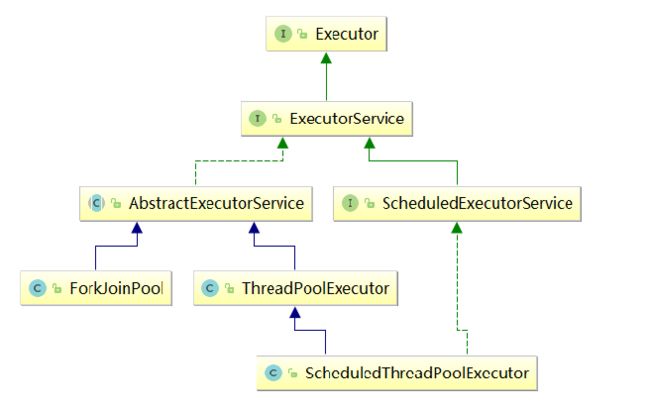Executor框架的两级调度模型
在HotSpot VM的线程模型中,Java线程(java.lang.Thread)被一对一映射为本地操作系统线程。Java线程启动时会创建一个本地操作系统线程;当该Java线程终止时,这个操作系统线程也会被回收。操作系统会调度所有线程并将它们分配给可用的CPU。
在上层,Java多线程程序通常把应用分解为若干个任务,然后使用用户级的调度器
应用程序通过Executor框架控制上层的调度;而下层的调度由操作系统内核控制,下层的调度不受应用程序的控制。
1.Executor框架的结构
Executor框架主要由3大部分组成如下:
1、任务。包括被执行任务需要实现的接口:Runnable接口或Callable接口。
2、任务的执行。包括任务执行机制的核心接口Executor,以及继承自Executor的
ExecutorService接口。Executor框架有两个关键类实现了ExecutorService接口
(ThreadPoolExecutor和ScheduledThreadPoolExecutor)。
3、异步计算的结果。包括接口Future和实现Future接口的FutureTask类。
下面是这些类和接口的简介。
·Executor是一个接口,它是Executor框架的基础,它将任务的提交与任务的执行分离开来。
·ThreadPoolExecutor是线程池的核心实现类,用来执行被提交的任务。
·ScheduledThreadPoolExecutor是一个实现类,可以在给定的延迟后运行命令,或者定期执行命令。ScheduledThreadPoolExecutor比Timer更灵活,功能更强大。
Future接口和实现Future接口的FutureTask类,代表异步计算的结果。
·Runnable和Callable接口实现类都可被ThreadPoolExecutor或Scheduled-ThreadPoolExecutor执行。
下面来看下使用示意图:
主线程首先要创建实现Runnable或者Callable接口的任务对象。工具类Executors可以把一
个Runnable对象封装为一个Callable对象(Executors.callable(Runnable task)或
Executors.callable(Runnable task,Object resule))。
然后可以把Runnable对象直接交给ExecutorService执行(ExecutorService.execute(Runnable
command));或者也可以把Runnable对象或Callable对象提交给ExecutorService执行(Executor-
Service.submit(Runnable task)或ExecutorService.submit(Callable
如果执行ExecutorService.submit(…),ExecutorService将返回一个实现Future接口的对象
(到目前为止的JDK中,返回的是FutureTask对象)。由于FutureTask实现了Runnable,程序员也可
以创建FutureTask,然后直接交给ExecutorService执行。
最后,主线程执行FutureTask.get()方法来等待任务执行完成。主线程也可以执行FutureTask.cancel(boolean mayInterruptIfRunning)来取消此任务的执行。
Executor框架的成员
主要介绍Executor框架的主要成员:ThreadPoolExecutor、ScheduledThreadPoolExecutor、
Future接口、Runnable接口、Callable接口和Executors。
(1)ThreadPoolExecutor(想深入理解实现原理可以看这篇文章:https://juejin.im/post/5d67e5b4e51d4561f64a0849)
ThreadPoolExecutor通常使用工厂类Executors来创建。Executors可以创建3种类型的
ThreadPoolExecutor:SingleThreadExecutor、FixedThreadPool和CachedThreadPool。
下面分别介绍这3种ThreadPoolExecutor。
(1) ThreadPoolExecutor
(1)FixedThreadPool。
是Executors提供的,创建使用固定线程数的FixedThreadPool的API。
public static ExecutorService newFixedThreadPool(int nThreads)
public static ExecutorService newFixedThreadPool(int nThreads, ThreadFactorythreadFactory
FixedThreadPool适用于为了满足资源管理的需求,而需要限制当前线程数量的应用场景,它适用于负载比较重的服务器。
(2)SingleThreadExecutor
下面是Executors提供的,创建使用单个线程的SingleThread-Executor的API。
public static ExecutorService newSingleThreadExecutor()
public static ExecutorService newSingleThreadExecutor(ThreadFactory threadFactory)
SingleThreadExecutor适用于需要保证顺序地执行各个任务;并且在任意时间点,不会有多个线程是活动的应用场景。
(3)CachedThreadPool。
下面是Executors提供的,创建一个会根据需要创建新线程的CachedThreadPool的API。
public static ExecutorService newCachedThreadPool()
public static ExecutorService newCachedThreadPool(ThreadFactory threadFactory)
CachedThreadPool是大小无界的线程池,适用于执行很多的短期异步任务的小程序,或者是负载较轻的服务器。
(2)ScheduledThreadPoolExecutor
ScheduledThreadPoolExecutor通常使用工厂类Executors来创建。Executors可以创建2种类型的ScheduledThreadPoolExecutor.
如下:
·ScheduledThreadPoolExecutor。包含若干个线程的ScheduledThreadPoolExecutor。
·SingleThreadScheduledExecutor。只包含一个线程的ScheduledThreadPoolExecutor。
下面是工厂类Executors提供的,创建固定个数线程的ScheduledThreadPoolExecutor的API。
public static ScheduledExecutorService newScheduledThreadPool(int corePoolSize)
public static ScheduledExecutorService newScheduledThreadPool(int corePoolSize,ThreadFactory)
ScheduledThreadPoolExecutor适用于需要多个后台线程执行周期任务,同时为了满足资源管理的需求而需要限制后台线程的数量的应用场景。
下面是Executors提供的,创建单个线程的SingleThreadScheduledExecutor的API
public static ScheduledExecutorService newSingleThreadScheduledExecutor()
public static ScheduledExecutorService newSingleThreadScheduledExecutor(ThreadFactory threadFactory)
SingleThreadScheduledExecutor适用于需要单个后台线程执行周期任务,同时需要保证顺序地执行各个任务的应用场景。
(3)Future接口
Future接口和实现Future接口的FutureTask类用来表示异步计算的结果。当我们把Runnable
接口或Callable接口的实现类提交(submit)给ThreadPoolExecutor或ScheduledThreadPoolExecutor时,ThreadPoolExecutor或ScheduledThreadPoolExecutor会向我们返回一个FutureTask对象。
Future submit(Callable task)
Future submit(Runnable task, T result)
Future<> submit(Runnable task)
FutureTask是Future的子类。
有一点需要读者注意,到目前最新的JDK8为止,Java通过上述API返回的是一个FutureTask对象。但从API可以看到,Java仅仅保证返回的是一个实现了Future接口的对象。在将来的JDK实现中,返回的可能不一定是FutureTask。
(4)Runnable接口和Callable接口
Runnable接口和Callable接口的实现类,都可以被ThreadPoolExecutor或Scheduled-
ThreadPoolExecutor执行。它们之间的区别是Runnable不会返回结果,而Callable可以返回结
果。
除了可以自己创建实现Callable接口的对象外,还可以使用工厂类Executors来把一个
Runnable包装成一个Callable。
下面是Executors提供的,把一个Runnable包装成一个Callable的API。
public static Callable下面是Executors提供的,把一个Runnable和一个待返回的结果包装成一个Callable的API。
public static Callable callable(Runnable task, T result) // 假设返回对象Callable2
当我们把一个Callable对象(比如上面的Callable1或Callable2)提交给
ThreadPoolExecutor或ScheduledThreadPoolExecutor执行时,submit(…)会向我们返回一个
FutureTask对象。我们可以执行FutureTask.get()方法来等待任务执行完成。
当任务成功完成后FutureTask.get()将返回该任务的结果。例如,如果提交的是对象Callable1,FutureTask.get()方法将返回null;如果提交的是对象Callable2,FutureTask.get()方法将返回result对象。
ThreadPoolExecutor详解
可以看这两篇文章:
从源码来看JDK8线程池ThreadPoolExecutor的实现原理(一)
https://juejin.im/post/5d67e5b4e51d4561f64a0849
从源码来看JDK8线程池ThreadPoolExecutor的实现原理(二)
https://juejin.im/post/5d688686e51d4561ce5a1c8b
·通过Executor框架的工具类Executors,可以创建3种类型的ThreadPoolExecutor。
·FixedThreadPool。
·SingleThreadExecutor。
·CachedThreadPool。
下面将分别介绍这3种ThreadPoolExecutor
FixedThreadPool详解
FixedThreadPool被称为可重用固定线程数的线程池。下面是FixedThreadPool的源代码实现。
public static ExecutorService newFixedThreadPool(int nThreads) {
return new ThreadPoolExecutor(nThreads, nThreads,0L, TimeUnit.MILLISECONDS,new LinkedBlockingQueue());
}
FixedThreadPool的corePoolSize和maximumPoolSize都被设置为创建FixedThreadPool时指定的参数nThreads。
FixedThreadPool的execute()方法的运行示意图:
1)如果当前运行的线程数少于corePoolSize,则创建新线程来执行任务。
2)在线程池完成预热之后(当前运行的线程数等于corePoolSize),将任务加入LinkedBlockingQueue。
3)线程执行完1中的任务后,会在循环中反复从LinkedBlockingQueue获取任务来执行。
FixedThreadPool使用无界队列LinkedBlockingQueue作为线程池的工作队列(队列的容量为
Integer.MAX_VALUE)。
FixedThreadPool使用无界队列作为工作队列会对线程池带来如下影响:
1)当线程池中的线程数达到corePoolSize后,新任务将在无界队列中等待,因此线程池中
的线程数不会超过corePoolSize。
2)由于1,使用无界队列时maximumPoolSize将是一个无效参数。
3)由于1和2,使用无界队列时keepAliveTime将是一个无效参数。
4)由于使用无界队列,运行中的FixedThreadPool(未执行方法shutdown()或
shutdownNow())不会拒绝任务(不会调用RejectedExecutionHandler.rejectedExecution方法)。
SingleThreadExecutor详解
SingleThreadExecutor是使用单个worker线程的Executor。
public static ExecutorService newSingleThreadExecutor() {
return new FinalizableDelegatedExecutorService(new ThreadPoolExecutor(1, 1, 0L, TimeUnit.MILLISECONDS,new LinkedBlockingQueue()));
}
SingleThreadExecutor的corePoolSize和maximumPoolSize被设置为1。其他参数与
FixedThreadPool相同。SingleThreadExecutor使用无界队列LinkedBlockingQueue作为线程池的工
作队列(队列的容量为Integer.MAX_VALUE)。SingleThreadExecutor使用无界队列作为工作队列
对线程池带来的影响与FixedThreadPool相同.
执行流程:
1)如果当前运行的线程数少于corePoolSize(即线程池中无运行的线程),则创建一个新线
程来执行任务。
2)在线程池完成预热之后(当前线程池中有一个运行的线程),将任务加入Linked-
BlockingQueue。
3)线程执行完1中的任务后,会在一个无限循环中反复从LinkedBlockingQueue获取任务来
执行。
3、CachedThreadPool详解
CachedThreadPool是一个会根据需要创建新线程的线程池。下面是创建CachedThread-Pool的源代码。
public static ExecutorService newCachedThreadPool() {
return new ThreadPoolExecutor(0, Integer.MAX_VALUE,60L, TimeUnit.SECONDS,new SynchronousQueue());
}
CachedThreadPool的corePoolSize被设置为0,即corePool为空;maximumPoolSize被设置为Integer.MAX_VALUE,即maximumPool是无界的。这里把keepAliveTime设置为60L,意味着CachedThreadPool中的空闲线程等待新任务的最长时间为60秒,空闲线程超过60秒后将会被终止。FixedThreadPool和SingleThreadExecutor使用无界队列LinkedBlockingQueue作为线程池的工作队列。
CachedThreadPool使用没有容量的SynchronousQueue作为线程池的工作队列,但CachedThreadPool的maximumPool是无界的。这意味着,如果主线程提交任务的速度高于maximumPool中线程处理任务的速度时,CachedThreadPool会不断创建新线程。极端情况下,CachedThreadPool会因为创建过多线程而耗尽CPU和内存资源。



